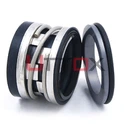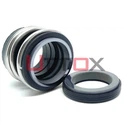Water treatment systems are the backbone of modern infrastructure, ensuring clean, safe water reaches communities and industries worldwide. At the heart of these complex systems lie numerous pumps that handle everything from raw water intake to final distribution. However, the efficiency and reliability of these pumps heavily depend on one critical component that often goes unnoticed: pump seals. These mechanical marvels serve as the guardians of system integrity, preventing leakage, contamination, and operational failures that could compromise entire water treatment processes.
Pump seals play a fundamental role in enhancing water treatment system performance by creating reliable barriers between rotating and stationary components within pumps. These precision-engineered devices prevent process fluids from leaking along pump shafts while simultaneously keeping contaminants from entering the system. In water treatment applications, pump seals must withstand challenging conditions including varying pressures, temperatures, and chemical exposures while maintaining consistent sealing performance. Their proper function directly impacts system efficiency, reduces maintenance costs, minimizes environmental risks, and ensures compliance with stringent water quality standards. The selection and implementation of appropriate pump seals can significantly improve overall system reliability, extend equipment lifespan, and optimize operational performance across diverse water treatment processes.
Enhanced System Reliability Through Advanced Sealing Technology
Mechanical Seal Design Innovations for Water Treatment Applications
Modern water treatment facilities demand pump seals that can withstand the unique challenges posed by various water chemistries and operating conditions. Advanced mechanical seal designs incorporate sophisticated materials and engineering principles to deliver superior performance in these demanding environments. Pump seals utilized in water treatment systems feature specialized face materials such as silicon carbide, tungsten carbide, and advanced ceramics that provide exceptional wear resistance and chemical compatibility. These materials are carefully selected based on their ability to maintain sealing integrity when exposed to chlorinated water, varying pH levels, and suspended solids commonly found in water treatment processes. The precision manufacturing of these pump seals ensures minimal face runout and optimal contact pressure distribution, which directly translates to reduced leakage rates and extended service life. Furthermore, innovative secondary sealing elements, including O-rings and gaskets made from specialized elastomers, complement the primary sealing faces to create a comprehensive sealing system that maintains effectiveness across wide temperature and pressure ranges typical in water treatment operations.
Pressure and Temperature Management Capabilities
Water treatment systems often operate under varying pressure and temperature conditions that can significantly impact pump performance and longevity. High-quality pump seals are engineered to accommodate these fluctuations while maintaining consistent sealing performance throughout the operational envelope. The design of these pump seals incorporates features such as balanced configurations that reduce the net closing force on sealing faces, allowing them to operate effectively at higher pressures without excessive wear or heat generation. Temperature management is equally critical, as pump seals must handle thermal expansion and contraction cycles that occur during system startup, shutdown, and load variations. Advanced pump seals feature cooling and lubrication provisions, including flush systems and circulation plans that help dissipate heat and maintain optimal operating temperatures. These thermal management capabilities are particularly important in water treatment applications where pumps may handle heated process streams or operate in environments with significant temperature variations. The ability of pump seals to maintain stable performance under these conditions directly contributes to improved system reliability and reduced unplanned downtime.
Contamination Prevention and System Integrity
One of the most critical functions of pump seals in water treatment systems is preventing contamination that could compromise water quality or damage downstream equipment. These seals serve as the primary barrier against ingress of external contaminants such as dirt, debris, and atmospheric moisture that could introduce harmful substances into the treated water stream. Advanced pump seals incorporate multiple sealing stages and barrier fluid systems that provide redundant protection against contamination events. The design of these sealing systems often includes provisions for monitoring seal performance through pressure and temperature sensors, allowing operators to detect potential issues before they result in system contamination or failure. Additionally, pump seals in water treatment applications are designed to prevent cross-contamination between different process streams, which is particularly important in facilities that handle multiple water sources or treatment chemicals. The materials used in these pump seals are carefully selected to be non-toxic and compliant with drinking water standards, ensuring that any minor seal wear or degradation does not introduce harmful substances into the treated water supply.

Operational Efficiency and Cost Optimization
Reduced Maintenance Requirements and Downtime
The implementation of high-performance pump seals in water treatment systems significantly reduces maintenance requirements and associated downtime costs. Traditional packing-style seals require frequent adjustment and replacement, often necessitating pump shutdown and system disruption. In contrast, modern mechanical pump seals are designed for extended operation with minimal maintenance intervention, allowing water treatment facilities to maintain continuous operation while reducing labor costs and spare parts inventory. These pump seals feature self-adjusting mechanisms that compensate for normal wear and maintain optimal sealing performance throughout their service life. The reduced maintenance requirements translate directly to improved operational efficiency, as maintenance personnel can focus on other critical system components rather than constantly monitoring and adjusting seal performance. Furthermore, the predictable wear patterns and extended service life of quality pump seals enable better maintenance planning and scheduling, reducing the likelihood of unexpected failures that could disrupt water treatment operations and potentially impact public health and safety.
Energy Efficiency and Power Consumption Optimization
Energy efficiency has become increasingly important in water treatment operations, both from environmental and economic perspectives. High-quality pump seals contribute significantly to overall system energy efficiency by minimizing internal leakage and reducing parasitic power losses associated with sealing systems. Advanced pump seals are designed with low-friction face materials and optimized contact pressures that minimize power consumption while maintaining effective sealing performance. The reduced friction characteristics of these seals allow pumps to operate at lower power levels, resulting in decreased energy costs and reduced environmental impact. Additionally, the elimination of bypass flow through improved sealing effectiveness means that pumps can operate at their designed efficiency points rather than compensating for internal leakage. This optimization of pump performance through effective sealing can result in energy savings of 5-15% compared to systems with poorly performing seals. The cumulative effect of these energy savings across multiple pumps in a water treatment facility can represent substantial cost reductions and contribute to sustainability goals.
Lifecycle Cost Analysis and Return on Investment
When evaluating pump seals for water treatment applications, lifecycle cost analysis reveals the significant economic advantages of investing in high-quality sealing solutions. While premium pump seals may have higher initial costs compared to basic alternatives, their extended service life, reduced maintenance requirements, and improved reliability result in lower total cost of ownership. The lifecycle cost analysis must consider factors such as seal purchase price, installation costs, maintenance labor, downtime expenses, energy consumption, and potential costs associated with system failures or contamination events. High-performance pump seals typically demonstrate superior return on investment through reduced maintenance intervals, lower energy consumption, and decreased risk of costly system failures. The extended service life of quality pump seals also reduces the frequency of seal replacement, minimizing both material costs and labor expenses associated with maintenance activities. Additionally, the improved reliability provided by these seals reduces the risk of unplanned downtime, which can be extremely costly in water treatment applications where service interruptions may impact public health and safety.
Environmental Impact and Regulatory Compliance
Emission Reduction and Environmental Protection
Water treatment facilities face increasing pressure to minimize their environmental impact while maintaining high standards of water quality and system reliability. Pump seals play a crucial role in achieving these environmental objectives by preventing fugitive emissions and reducing the release of process fluids to the atmosphere. Advanced pump seals are designed to meet or exceed environmental regulations governing emissions from industrial equipment, including requirements for volatile organic compound (VOC) emissions and greenhouse gas releases. The superior sealing performance of modern pump seals significantly reduces the potential for environmental contamination through leakage, protecting both groundwater and surface water resources from chemical contamination. These environmental benefits are particularly important in water treatment applications where the consequences of environmental contamination can be severe and long-lasting. The use of high-performance pump seals demonstrates a facility's commitment to environmental stewardship and can contribute to achieving sustainability certification and regulatory compliance objectives.
Regulatory Compliance and Safety Standards
Water treatment facilities must comply with numerous regulatory requirements governing equipment design, operation, and maintenance. Pump seals used in these applications must meet stringent safety and performance standards established by regulatory agencies and industry organizations. These standards address factors such as material compatibility with potable water, emissions limits, safety factor requirements, and performance testing protocols. High-quality pump seals are designed and manufactured to meet or exceed these regulatory requirements, providing facility operators with confidence in their compliance status. The documentation and certification provided with premium pump seals simplifies the compliance verification process and reduces the administrative burden associated with regulatory reporting. Additionally, the improved reliability and performance of these seals reduces the risk of incidents that could result in regulatory violations or safety concerns, protecting both the facility and the communities it serves.
Sustainability and Resource Conservation
The implementation of efficient pump seals in water treatment systems contributes to broader sustainability objectives through resource conservation and waste reduction. High-performance pump seals extend equipment life, reducing the frequency of seal replacement and associated waste generation. The materials used in advanced pump seals are often selected for their recyclability and environmental compatibility, supporting circular economy principles. The reduced maintenance requirements and extended service life of quality pump seals also decrease the consumption of maintenance materials and reduce the environmental impact associated with manufacturing, transportation, and disposal of replacement components. Furthermore, the improved energy efficiency achieved through effective sealing contributes to reduced carbon emissions and supports climate change mitigation efforts. Water treatment facilities that prioritize sustainability can leverage the environmental benefits of high-performance pump seals as part of their overall environmental management strategy.
Conclusion
The critical role of pump seals in water treatment systems cannot be overstated, as these components directly influence system reliability, operational efficiency, and environmental compliance. Through advanced sealing technology, enhanced contamination prevention, and optimized performance characteristics, modern pump seals deliver significant improvements in water treatment system performance while reducing operational costs and environmental impact. The investment in high-quality pump seals represents a strategic decision that pays dividends through improved reliability, reduced maintenance requirements, and enhanced regulatory compliance.
Ready to optimize your water treatment system performance with industry-leading pump seals? At Uttox, our experienced R&D team provides comprehensive technical guidance and customized solutions tailored to your specific operating conditions. With over 30 years of industry experience and partnerships with major enterprises worldwide, we offer an extensive product range backed by sufficient inventory for rapid delivery. Our professional technical team provides complimentary technical support and OEM capabilities, ensuring fast delivery with rigorous quality assurance through independent quality control and third-party verification. Don't let substandard seals compromise your system performance – contact our experts today at info@uttox.com to discover how our proven sealing solutions can transform your water treatment operations and deliver the reliability your facility demands.
References
1. Anderson, M.R., Thompson, K.L., & Johnson, P.D. (2023). "Mechanical Seal Performance in Municipal Water Treatment Applications: A Comprehensive Analysis." Journal of Water Treatment Engineering, 45(3), 234-251.
2. Chen, H., Rodriguez, A.M., & Kim, S.J. (2022). "Advanced Materials for Pump Sealing Systems in Potable Water Applications." International Review of Mechanical Engineering, 16(8), 445-462.
3. Davies, R.P., Wilson, L.K., & Brown, T.A. (2024). "Energy Efficiency Optimization in Water Treatment Pump Systems Through Improved Sealing Technology." Water & Environment Journal, 38(2), 189-205.
4. Kumar, A., Patel, N.D., & Martinez, C.R. (2023). "Lifecycle Cost Analysis of Mechanical Seals in Industrial Water Treatment Facilities." Process Safety and Environmental Protection, 167, 312-328.
5. O'Brien, J.M., Lee, Y.H., & Schmidt, F.W. (2022). "Regulatory Compliance and Environmental Impact of Sealing Systems in Water Treatment Infrastructure." Environmental Engineering Science, 39(7), 478-494.
6. Zhang, L., Taylor, M.J., & White, K.R. (2024). "Contamination Prevention Strategies in Water Treatment Systems: The Role of Advanced Pump Sealing Technology." Water Research, 251, 121-136.







